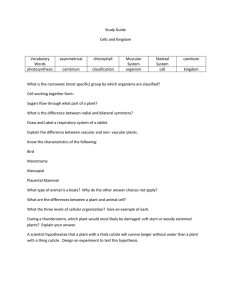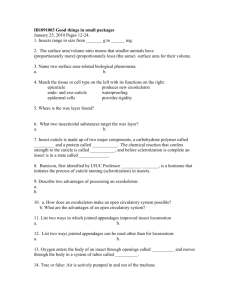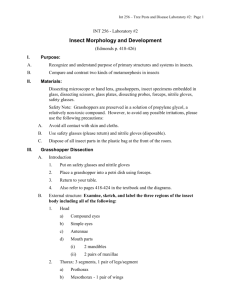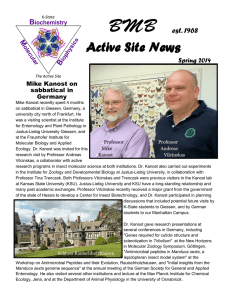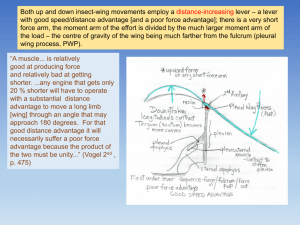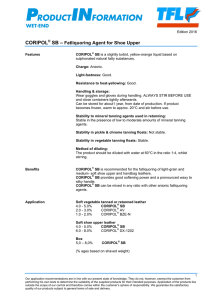Insect Cuticle as a Biomimetic Material. Eichler, C. ; Lomakin, J.
advertisement
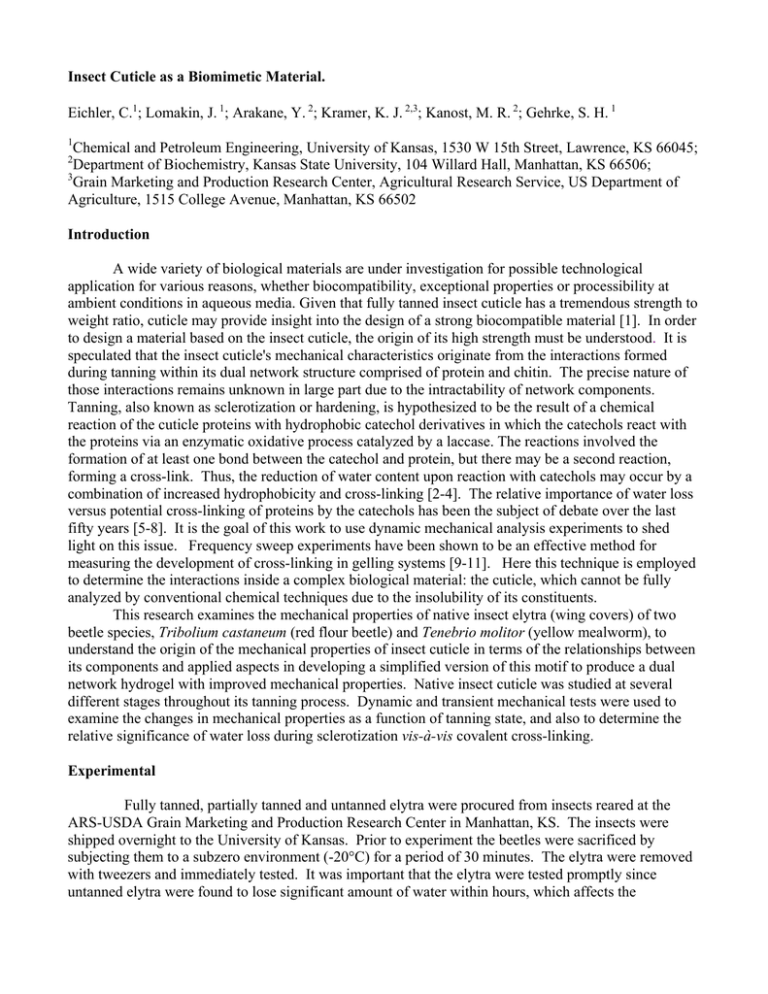
Insect Cuticle as a Biomimetic Material. Eichler, C.1; Lomakin, J. 1; Arakane, Y. 2; Kramer, K. J. 2,3; Kanost, M. R. 2; Gehrke, S. H. 1 1 Chemical and Petroleum Engineering, University of Kansas, 1530 W 15th Street, Lawrence, KS 66045; Department of Biochemistry, Kansas State University, 104 Willard Hall, Manhattan, KS 66506; 3 Grain Marketing and Production Research Center, Agricultural Research Service, US Department of Agriculture, 1515 College Avenue, Manhattan, KS 66502 2 Introduction A wide variety of biological materials are under investigation for possible technological application for various reasons, whether biocompatibility, exceptional properties or processibility at ambient conditions in aqueous media. Given that fully tanned insect cuticle has a tremendous strength to weight ratio, cuticle may provide insight into the design of a strong biocompatible material [1]. In order to design a material based on the insect cuticle, the origin of its high strength must be understood. It is speculated that the insect cuticle's mechanical characteristics originate from the interactions formed during tanning within its dual network structure comprised of protein and chitin. The precise nature of those interactions remains unknown in large part due to the intractability of network components. Tanning, also known as sclerotization or hardening, is hypothesized to be the result of a chemical reaction of the cuticle proteins with hydrophobic catechol derivatives in which the catechols react with the proteins via an enzymatic oxidative process catalyzed by a laccase. The reactions involved the formation of at least one bond between the catechol and protein, but there may be a second reaction, forming a cross-link. Thus, the reduction of water content upon reaction with catechols may occur by a combination of increased hydrophobicity and cross-linking [2-4]. The relative importance of water loss versus potential cross-linking of proteins by the catechols has been the subject of debate over the last fifty years [5-8]. It is the goal of this work to use dynamic mechanical analysis experiments to shed light on this issue. Frequency sweep experiments have been shown to be an effective method for measuring the development of cross-linking in gelling systems [9-11]. Here this technique is employed to determine the interactions inside a complex biological material: the cuticle, which cannot be fully analyzed by conventional chemical techniques due to the insolubility of its constituents. This research examines the mechanical properties of native insect elytra (wing covers) of two beetle species, Tribolium castaneum (red flour beetle) and Tenebrio molitor (yellow mealworm), to understand the origin of the mechanical properties of insect cuticle in terms of the relationships between its components and applied aspects in developing a simplified version of this motif to produce a dual network hydrogel with improved mechanical properties. Native insect cuticle was studied at several different stages throughout its tanning process. Dynamic and transient mechanical tests were used to examine the changes in mechanical properties as a function of tanning state, and also to determine the relative significance of water loss during sclerotization vis-à-vis covalent cross-linking. Experimental Fully tanned, partially tanned and untanned elytra were procured from insects reared at the ARS-USDA Grain Marketing and Production Research Center in Manhattan, KS. The insects were shipped overnight to the University of Kansas. Prior to experiment the beetles were sacrificed by subjecting them to a subzero environment (-20°C) for a period of 30 minutes. The elytra were removed with tweezers and immediately tested. It was important that the elytra were tested promptly since untanned elytra were found to lose significant amount of water within hours, which affects the mechanical properties. To prepare dried samples, the elytra were left in a desiccator at room temperature until a constant mass was reached (residual water estimated < 1%). To evaluate the effect of laccase on the mechanical properties, dsRNA for TcLac (2 ng per insect) was injected into prepupae and then the elytra were removed from resulting 72 h old adults as described above [12]. Sample dimensions were determined via calipers and microscopic measurements using a digital micrometer. A TA Instruments RSAIII dynamic mechanical analyzer was used to perform all of the mechanical measurements. Several mounting techniques were employed. Soft samples were gripped directly between the instrument’s metal clamps. Harder, brittle samples such as dried and tanned Tribolium elytra required strips of plastic to be clamped in the mounts and epoxy used to attach the sample to the strips. The epoxy dried for 1 h, fixing the sample without damage [13]. Once the samples were mounted, ultimate properties were determined via transient stress-strain measurements. Extension took place at 0.01 mm/s to allow for sufficient data collection. On occasion, specimen failure occurred in discrete increments, so the ultimate and initial fracture stress (and strains) differed; in such cases the initial fracture point is reported. Additional experiments included strain sweeps and frequency sweeps. For strain sweeps, a frequency of 1 Hz (6.28 rad/s) was used between boundary strains of 0.01% and 10%. The linear viscoelastic region in these sweeps was maintained past the strain of 0.2% in all cases, thus a strain of 0.2% was used for all frequency sweep experiments. Results The elytra were tested at three different stages of tanning, as well as in the dried state and for Tribolium, a laccase-suppressed sample. These stages were untanned, 24 hrs after eclosion, and fully tanned. It was determined that Tenebrio elytra tan within a few days, whereas Tribolium require over 7 days to tan fully. Transient mechanical testing indicates similar mechanical properties for elytra from either species. This is not surprising since the Tenebrio and Tribolium elytra are morphologically and geometrically similar. Untanned elytra from both species displays a fracture stress of 0.7 ± 0.1 MPa, a fracture strain of 10 ± 6 % and a Young's modulus (YM) of 8 ± 3 MPa. These transient data are consistent with data collected via dynamic analysis: the elastic modulus (E') for untanned elytron via strain sweep at 1 Hz is equal to 30 ± 6 MPa. When fully tanned, elytron fracture stress increases over 60 times to 45 ± 12 MPa whereas fracture strain decreases to 3 ± 1 %. Stiffness increases over 200 times, as shown by a YM of 1670 ± 380 MPa and an elastic modulus of 4860 ± 1840 MPa. Tribolium beetles that have been inhibited from undergoing the tanning process by RNA interference of the insect cuticle tanning enzyme (laccase) were compared to untanned and partially tanned specimens [12]. The average fracture stress for 72 h laccase inhibited Tribolium elytra was only 3 ± 1 MPa with a fracture strain 3 ± 2%, a factor of 3 lower then for partially tanned (24 h) samples. Sample stiffness had increased only by a factor of 25 when compared to untanned samples as represented by a YM of 200 ± 120 MPa. Frequency sweep experiments yield two key parameters: the elastic modulus E’ at 1 Hz, and the frequency dependence exponent of the power law E’ ~ ωn. E’ becomes frequency independent (i.e., n approaches zero) as the extent of cross-linking increases. Thus by measuring the magnitude of the E’ and the power law exponent, conditions can be identified that are caused by increased cross-linking (reduced n), along with the increased rigidity as measured by E’ [9-11]. These parameters are extracted from the data in Figure 1 and summarized in Table 1. The cuticle water content ranges from 65±6% for an untanned Tribolium cuticle, to less than 10% in the tanned cuticle, and less than 1% (estimated) in the dried samples. From Table 1, the cuticle of both species immediately after eclosion has low E’ magnitudes and high exponents. The tanning proceeds more rapidly in Tenebrio than Tribolium, as seen by the combination of the decreasing exponent and increasing modulus at 24 hours. A fully tanned Tenebrio 10 10 Elastic Modulus E' (GPa) Tanned and Dried Tanned 1 1 24 hrs of Tanning Laccase Inhibited 0.1 0.1 Untanned and Dried Untanned 0.01 0.01 0.1 1 10 100 1000 0.1 1 Frequency (rad/s) 10 100 1000 Frequency (rad/s) Figure 1 - Frequency sweeps at 0.2% strain of Tribolium (left) and Tenebrio elytra (right); the curves are composites of multiple runs, on average four each. The region between 1 and 100 rads/s was used to calculate the frequency dependence exponent. Tribolium castaneum Cuticle State E' at 1Hz MPa 0 tanning 40 ± 4 0 tanning (dried) 1100 ± 40 72 hr RNA Inhib. 230 ± 140 24 hr tan 190 ± 120 Fully tanned 1200 ± 100 Fully tanned (dried) 4100 ± 900 Exponent of Frequency Dependence Power Law E' 0.095 ± 0.012 0.069 ± 0.015 0.033 ± 0.005 0.082 ± 0.012 0.036 ± 0.003 0.027 ± 0.001 Tenebrio molitor Cuticle State 0 tanning 0 tanning (dried) 24 hr tanned Fully Tanned Fully tanned (dried) MPa 37 ± 9 170 ± 20 Exponent of Frequency Dependence Power Law E' 0.130 ± 0.037 0.040 ± 0.005 540 ± 430 2500 ±1200 3500 ± 700 0.035 ± 0.001 0.021 ± 0.002 0.018 ± 0.001 E' at 1Hz Table 1 - E’ values and E’ power law exponents for frequency sweeps. Increased tanning time increases modulus and reduces the exponent, while drying increases modulus with a lesser effect on the exponent. exhibits a stronger, more highly crosslinked structure, as indicated by the higher modulus and exponent closer to zero in the fully tanned data. The results compiled in Table 1 show that the decrease in water content in untanned cuticle by itself results in a change in stiffness of over 25 times in the case of Tribolium and over 4 times for Tenebrio. In comparison, the natural tanning increases E’ over 30 times for Tribolium and over 60 times for Tenebrio. Since the tanned cuticle still contains ~9% water, the most apt comparison may be between the untanned, dried elytra and the tanned, dried elytra since those samples have the same water content. Comparing the dried samples, the tanning accounted for an additional increase in stiffness of approximately 4 times for Tribolium and 20 times in the case of Tenebrio. The additional increase cannot be accounted for by water loss, indicating that the reaction of oxidized catechols with cuticular proteins plays an important role in directly stiffening the insect exoskeleton. Thus drying has a different effect on the cuticle than tanning. At a given tanning state, drying increases the modulus and decreases the exponent, but to a lesser extent than increased tanning time. These differences indicate that tanning involves cross-linking as well as dehydration. However, the two species differ in the effect of drying on their elytra. For Tribolium, the exponent is nearly independent of drying, but substantially increases the modulus of the cuticle, nearly 30 times upon drying untanned cuticle and 3 times upon drying fully tanned cuticle. In contrast, Tenebrio exhibits a slight decrease in exponent, while the modulus of the untanned cuticle increases less than 5 times upon drying, and less than 50% upon drying fully tanned cuticle. In both cases, however, the conclusion can be drawn that tanning involves cross-linking reactions in addition to dehydration. The use of RNA interference techniques with Tribolium to suppress the expression of the enzymes involved in tanning, notably laccases, has been shown to cause dramatic morphological changes in the developing insects [11]. These mechanical tests can quantify the observed changes and help identify the role of the enzymes in the cuticle development. Here the results of a minimally suppressed laccase are shown. In this case, it takes 72 h post-eclosion for the laccase-suppressed insect to reach the same level of E’ that the normal insect reaches in 24 hours. However, this sample has an exponent equal (within experimental uncertainty) to the fully tanned Tribolium. This indicates that cross-linking reactions can occur in this system, but that the overall incorporation of catechol into the cuticle is significantly reduced (indicted by a water content of 54 ±5%), leaving it cross-linked but hydrated and weak (insects treated with higher dsRNA are too deformed to survive 72 h). It may also be that under laccase-suppression another enzyme may provide an alternate pathway for cross-linking. Discussion Ultimate and dynamic mechanical properties of elytra from Tenebrio and Tribolium at various tanning stages were collected. Dynamic testing, yielding the elastic modulus (E’) and frequency exponent (n) provided evidence that covalent cross-linking is involved in the tanning process. It was determined that water loss in the insect cuticle accounts for some of the increase in cuticle fracture stress and in sample stiffness at the cost of decreasing fracture strain. While water loss does increase the mechanical strength of tanned and untanned samples, the data indicates that covalent cross-linking develops during sclerotization to yield a mechanically strong, fully tanned insect cuticle. Cuticle can be viewed as a composite material composed of independent dual polymer networks (protein and chitin), potentially arranged as either interpenetrating networks (IPNs) or as semiIPNs. Recent work by Gong, Osada, and coworkers illustrated the potential of such motifs in synthetic polymer systems tested under compression [14, 15]. Poly-2-acrylamido-2-methylpropanesulfonic acid/ poly acrylamide (PAMPS/ PAAm) as well as agarose/poly-2-hydroxyethyl methacrylate (PHEMA) are two IPN and semi-IPN gels that were investigated as synthetic model analogs to insect cuticle and analyzed similarly. The interpenetrating networks (IPNs) consist of a secondary network formed within a primary one during a two-step process. The secondary polymer may (IPN) or may not (semi-IPN) be cross-linked. Substantial improvements of mechanical properties were seen when the primary network consisting of a low fracture stress and low fracture strain but high modulus hydrogel such as PAMPS or agarose was combined with a more ductile, lower modulus secondary network like PAAm or PHEMA. Results showed that in both cases the IPNs are orders of magnitude stiffer than the respective secondary network alone, yet they are far more flexible than the primary network by itself. The fracture stress of these synthetic IPN's is close to that found in human cartilage; thus application in the biomedical field of this motif may be possible. The high mechanical strength of such IPNs may be a useful mimic of the cuticle motif that may have the chitin physically entangled within a network of cross-linked protein. Acknowledgements This work has been funded by National Science Foundation Grant MCB0236039. References 1. 2. 3. 4. 5. 6. 7. 8. 9. 10. 11. 12. 13. 14. 15. Vincent, J. F. V., Wegst, U. G. K., Design and mechanical properties of insect cuticle. Arthropod Structure & Development 2004, 33, 187–199. Kramer, K. J.; Kanost, M. R.; Hopkins, T. L.; Jiang, H.; Zhu, Y. C.; Xu, R.; Kerwin, J. L.; Turecek, F., Oxidative conjugation of catechols with proteins in insect skeletal systems. Tetrahedron 2001, 57, (2), 385-392. Suderman, R. Cuticle Sclerotization in Manduca sexta: an in vitro sclerotization model. Ph.D. Thesis, Kansas State University, Manhattan, KS, 2004. Wappner P., Hopkins T.L., Kramer K. J., Cladera J. L., Manso F., Quesada-Allué L.A., Role of catecholamines and β-alanine in puparial color of wild-type and melanic mutants of the Mediterranean fruit fly (Ceratitis capitata) Journal of Insect Physiology 1996, 4, 455-461. Wappner P., and Quesada-Allué L.A., Water loss during cuticle sclerotization in the medfly Ceratitis capitata is independent of catecholamines. J. Insect Physiology 1996, 42, 705-709. Wappner P., Kramer K. J., Hopkins T. L., Merritt M., Schaefer J., Quesada-Allue L.A. White pupa: a Ceratitis capitata mutant lacking catecholamines for tanning the puparium. Insect Biochemistry and Molecular Biology 1995, 25, 365-373. Vincent J. F. V., and Ablett A., Hydration and tanning in insect cuticle. Journal of Insect Physiology 1987, 33, 973-979 Sugumaran, M., Unified mechanism for sclerotization of insect cuticle. Advances in Insect Physiology 1998, 27, 229-334. Wachsstock, D.H., W.H. Schwarz, and T.D. Pollard, Cross-Linker Dynamics Determine the Mechanical Properties if Actin Gels. Biophysical Journal, 1994, 66, 801–809. Kong, H.J., E. Wong, and D.J. Mooney, Independent Control of Rigidity and Toughness of Polymeric Hydrogels. Macromolecules, 2003, 36, 4582-4588. Ross-Murphy, S. B.; Clark, A. H., Structural and Mechanical Properties of Biopolymer Gels. In Advances in Polymer Science, SpringerVerlag: Heidelberg, 1987, 83, 57-207. Arakane Y., Muthukrishnan S., Beeman R. W., Kanost M. R., Kramer K. J. Laccase 2 is the phenoloxidase gene required for beetle cuticle tanning. Proc Natl Acad Sci U S A 2005, 102, 11337-11342. Eichler C., Insect cuticle as a motif for biomimetic materials. M.S. Thesis, University of Kansas, Lawrence, KS 2005. Gong J. P., Katsuyama Y., Kurokawa T., Osada Y. Double-Network Hydrogels with Extremely High Mechanical Strength. Advanced Materials, 2003, 15, 1155-1158. Na, Y., Kurokawa T., Katsuyama Y., Tsukeshiba H., Gong J. P., Osada Y., Okabe S., Karino T., Shibayama M., Structural Characteristics of Double Network Gels with Extremely High Mechanical Strength. Macromolecules, 2004. 37(14): p. 5370 - 5374.
